After extensive study and public consultation, TTC staff will present a plan for bus replacement of the Scarborough RT to their Board at its April 14, 2022 meeting. Although it is a long report, much of it has appeared before during the consultative process and in an interim report to the Board. Interested readers can browse the full version, and I will only touch on the major points here.
My apologies for the resolution on some of the drawings included here. The versions in the TTC report online are not good, but if better renditions show up in the future, I will replace the originals here.
The Scarborough RT is on its last legs and, frankly, should have been replaced years ago. Let us not get into the whole subway/LRT debate as that train has left the station. However, the constant delay in making any decision has now pushed the opening of any replacement service well beyond the reasonable lifetime of the existing SRT fleet, and even that will require work to keep it operating until bus facilities are ready.
Various dates for the SRT shutdown are proposed, and these depend on completion of alternate bus terminal facilities. Thanksgiving weekend would certainly be an ironic cutover date.
The candidate dates for Q4 2023 would mean the last day of train service could be: Saturday October 14, 2023; or, Saturday November 25, 2023. If construction is complete ahead of schedule, a September closure date could also be possible, on Saturday September 2, 2023.
TTC Report at p. 15
The Recommended Option
When the need to close the SRT before the Scarborough Subway Extension opened became apparent, the first thought was that riders would be consigned to buses plying the roads from Scarborough Town Centre to Kennedy Station for many years.
To no great surprise, there was a better idea that emerged during the consultations: use as much of the existing SRT right-of-way as possible for a bus roadway bypassing local street and intersection congestion and providing a direct access to Kennedy Station. That is the scheme that has been recommended, named in the report “Option 1 Hybrid Line 3 ROW” (Right-of-way).
As shown in the map below, the bus service will operate from STC station to Kennedy on street to Ellesmere Station and then on a new road in the existing SRT right-of-way to Kennedy Station. Stops will roughly match the existing SRT, except for McCowan. A new stop will be added at Tara Avenue, ironically a proposed station location decades ago when the SRT was to be built as a conventional LRT line.
The frequency of service is such that aggressive transit priority measures will be needed for the on-street portion.
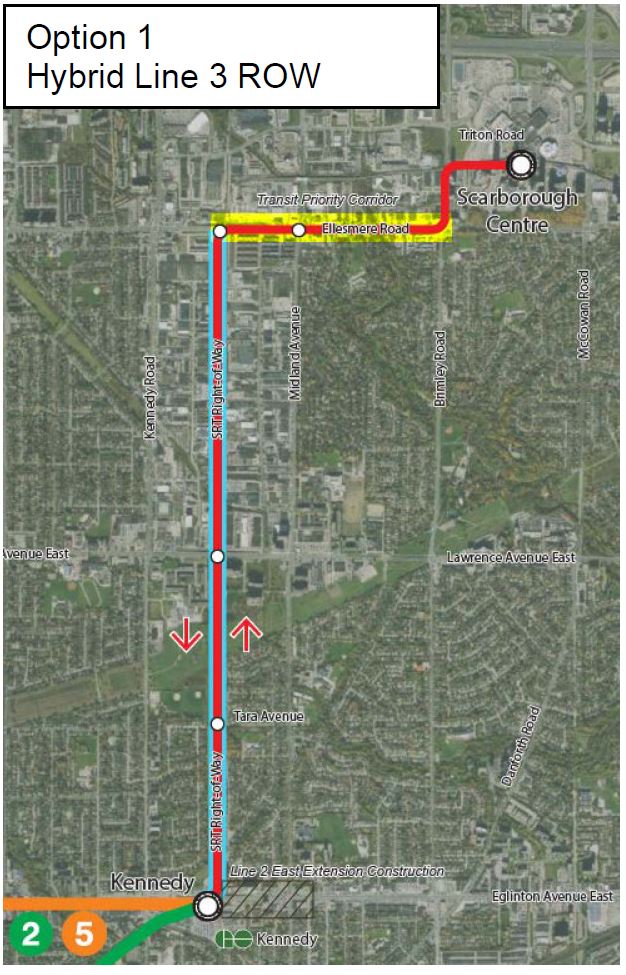
Conversion from the SRT to a bus roadway cannot happen overnight as the existing train infrastructure must be removed (rails, power) and the remaining facilities adapted as a roadway. In places the existing slab is not wide enough for two bus lanes and some expansion will be needed. The interim scheme with buses using local streets is shown below.
Buses would run between Ellesmere and Eglinton via Midland southbound and via Kennedy northbound. Using separate streets spreads the effect of any transit priority changes between two of them rather than concentrating it on a single corridor. This clockwise arrangement means that the loop requires only three right turns and one left turn and will somewhat simplify movements at intersections.
Brimley was considered as a route, but the road is not in good enough condition to support very frequent bus service.

The schedule for the conversion stretches out to 2025.
One option that does not appear to have been considered is whether it would be possible to complete the southern section from Lawrence to Eglinton and open it part way through the project to gain the advantage of a direct access to Kennedy Station as soon as possible.
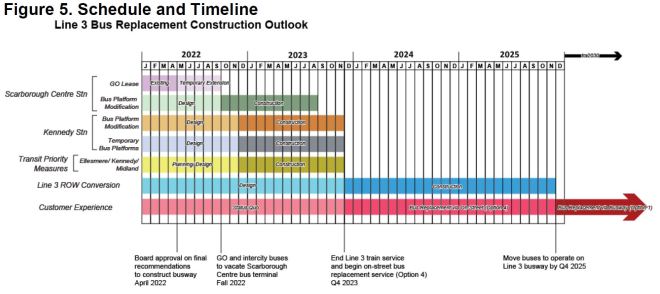
As the chart above shows, work is needed at both Scarborough Centre and Kennedy Stations in order to provide capacity for considerably more bus service than they see today. This work will be required before the SRT closes so that the replacement bus service will fit at these termini.
Scarborough Centre Station Modifications
(With apologies for the image quality.)
Some of the bus bays must be adjusted for use by articulated buses that will be used on the replacement service.

The TTC bus area will be expanded to take over the bays now used by GO Transit, and GO will shift to on street loading as described in the report:
Metrolinx staff evaluated more than 10 relocation sites and considered factors such as customer connectivity to the mall and the TTC bus terminal; operational needs of GO bus operations with limited construction; avoiding areas that would be impacted by construction of the Line 2 East Extension; and, enable implementation in a limited timeframe to ensure continuity of GO bus service. In collaboration with the TTC and the City, and the local ward Councillor, Metrolinx is pursuing relocating its bus platforms to Borough Drive, west of Scarborough Town Centre. Metrolinx will be seeking City Council approval for an on-street occupancy permit and changes to traffic regulations to enable this.
Customers transferring between regional and intercity services and the TTC may do so at an improved stop on Triton Road at Borough Drive. The GO and intercity bus platforms on Borough Drive will be temporary, between 2022 and 2030, until the opening of Line 2 East Extension.
The TTC will continue to work with Metrolinx to explore opportunities to improve integration for customers. This will include exploring fare integration opportunities such as re-introducing the Double Discount Fare to make GO services a more affordable alternative.
TTC Report at pp 16-17
This change will occur in fall 2022 so that reconstruction of the GO bus area for TTC use can begin. To call this a “temporary” condition certainly stretches the meaning of the word.
Using a double-discount fare will only slightly compensate for the less convenient transfer from GO to TTC. There is no discussion of GO adjusting its routes to feed into the GO train network, especially considering the planned increases in service that will be in place long before the SSE opens, if GO’s plans are to be believed. Such changes are, of course, a provincial decision beyond the TTC’s control.
Kennedy Station Modifications
(With apologies for the image quality.)
Kennedy Station will require adjustments to the main terminal for articulated bus service, and a secondary terminal for routes displaced by the SRT shuttle. Figure 7 below shows vehicle movements for the interim on-street bus operation. This will be challenging on top of the volume of bus traffic already at the station.

Figure 8 shows a temporary loop and platform area in what is now the south parking lot of Kennedy Station. This would remain in operation until 2030 when the SSE opens.
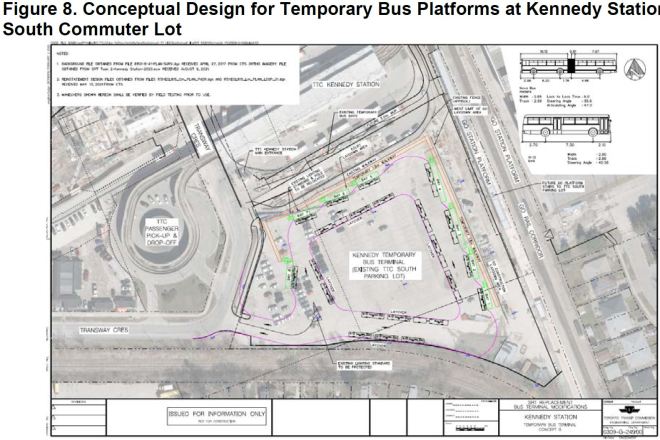
Once the SRT right-of-way conversion as a bus roadway is complete, the route at Kennedy Station will be as shown in Figure 7. Note that the north parking lot is already slated for development, and once the SSE opens the south parking area can also be repurposed.

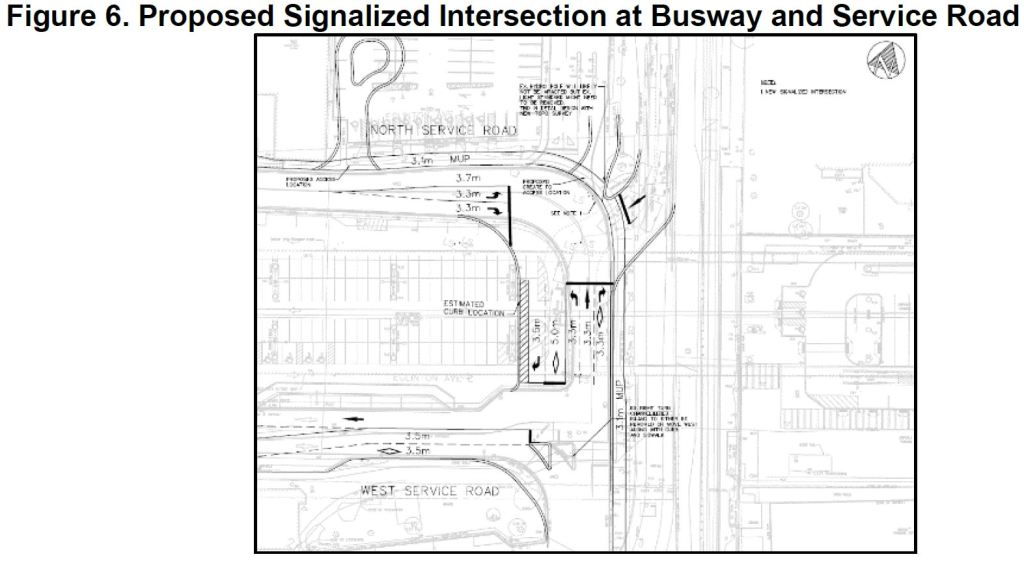
Bus connection at Ellesmere
Although Ellesmere Station does not provide for bus-to-RT transfers at the same level seen at Lawrence East Station, there are roadways from Ellesmere into the station area that are used today by the 95C York Mills service. Stops for walk-in passengers could be provided on the new connecting roadway to the bus corridor as shown below.

Bus connection at Lawrence East
Lawrence East Station has a full bus loop used by the 54 and 954 Lawrence East service to connect with the RT. A new road connection would be built to the bus corridor, and stops for walk-in traffic could be provided as shown below.
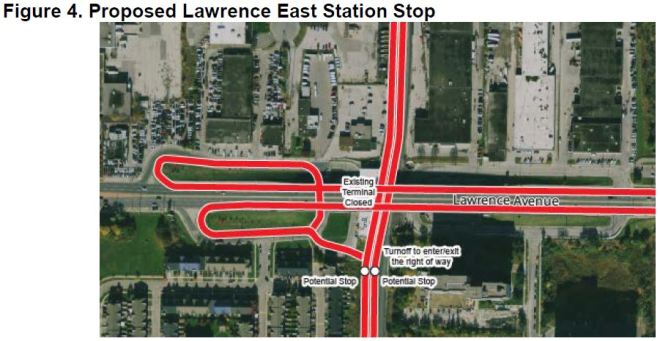
Tara Road Stop
At Tara Avenue, where there is currently a pedestrian bridge over the SRT, platforms can be added on either side of the corridor.

Bus Fleet Requirements
The TTC projects that it will require additional buses to provide this service: 66 while the operation is entirely on-street, and 57 when the bus roadway opens. Assuming that new buses are purchased for this, they will still have life remaining by the time the SSE opens, and so they would shift into the general fleet. From an accounting point of view, their residual value would not be counted as an SRT replacement cost.
Although the station designs are clearly intended to support articulated buses on this service, it is not clear which size of bus, or its propulsion has been used in the estimates below. The capital cost of 66 buses is shown as $93 million translating to $1.41 million/bus. Moreover, there is a question of when the buses would be purchased relative to the transition to eBuses in the TTC’s fleet. (There is a separate report on the eBus project in the meeting agenda, and I will address it in another article.)
The TTC currently has a substantial surplus of buses thanks both to covid-era service changes and to its historically high spare vehicle ratio. Whether they will actually need more buses for the SRT depends on how well they plan to utilize what they already own, and whether the SRT conversion is simply an opportunity to buy more buses on someone else’s budget.
The additional buses required to provide this service from 2023 to 2030 will require a peak requirement of 66 additional buses, including spares. These additional buses, including the cost of overhaul, have a capital value of approximately $93 million. By 2025, when the busway conversion is complete, this requirement will be reduced to 57 additional peak buses, including spares, and will be required up to 2030 when the Line 2 East Extension is open. At that time, there is residual value of approximately $44.5 million on the additional buses. The total capital cost of buses attributable to the bus replacement service between 2023 and 2030 is approximately $48.5 million. Sufficient funds are included in the 2022-2031 Capital Budget and Plan to support the fleet requirements.
TTC Report at p. 5
Capital and Operating Costs
Capital costs for this scheme are shown below. There is a shortfall in the capital budget between currently planned spending and the expected cost of (a) keeping the SRT in operation and (b) making the physical changes needed for the SRT-to-bus-roadway option. Responsibility for these costs is a matter for discussion between the TTC, City and Metrolinx.
The TTC through the City, will continue to discuss funding requirements with the Province in order to fully fund the costs associated with implementing a bus replacement service until the Line 2 East Extension is opened for service in 2030 as well as the decommissioning costs of the Line 3 SRT. The information in this report will inform the ongoing financial reconciliation exercise between the City and Province in relation to the upload of the Line 2 East Extension project in 2019.
TTC Report at p. 5
Note that there is no provision for the purchase of net new buses which is carried in a separate line in the TTC’s budget.

Once the bus replacement service takes over from the SRT, operating costs will go up because buses are more labour intensive than the RT. There will also be a small loss of revenue from the south parking lot at Kennedy Station.


I do wonder where we’d be at if the Scarborough RT had been opened as an LRT as TTC proposed. Probably in a better situation! Andy B.
LikeLike
Steve, direct access to Kennedy by bus is not easy. The guideway heading into the station is also the southbound platform for Kennedy GO. Looking at the big picture, finishing Kennedy GO should be a higher priority.
By 2023, the Stouffville line should be double track from Kennedy to Unionville GO. All the station expansions would be done. This would mean at least service every 30 minutes or less both directions all day. It would be prudent for the TTC to beef up east west service. If customers are heading downtown, taking an east west rocket route like the Finch or Sheppard rocket to a GO station might be more efficient. By that time, Metrolinx would probably have 100% co fare subsidy at that time with the TTC.
By 2026, Finch Kennedy station would open. At that time, Metrolinx is promising much more frequent service. Beefing up east west service would be much more practical and less costly than running buses on a busway with a transfer at Kennedy. Unless the TTC is planning to keep the busway and run Lawrence buses into Kennedy into the future.
Steve: There is a drawing of the link from the SRT corridor to Kennedy Station on page 25 of the report. It clearly shows the link north of Eglinton where the parking lot entrance is today, and well clear of the GO platform. I have added this drawing to the article for completeness.
I agree that GO has a role to play here. However, it’s important to remember that during the period of developing an SRT replacement, Toronto has been shafted by the loss of a GO co-fare, and uncertainty about just how much service GO will actually add given the tepid recovery of their demand. Even at planned levels, the longer transfer distances to/from GO trains and the wider headways would make using GO as an SRT replacement just to reach Kennedy rather tedious. People who complain about long transfers today have a good thing compared to what a GO transfer would involve. GO really can only address demand bound for the business district, not the wider area served by the Danforth subway such as the University district. Then there is the matter of demand within Scarborough itself. It’s not a case where there is a single “solution”, but rather a collection of options that have to work together.
LikeLike
This caused me to laugh and laugh. Toronto has not been able to use the existing transit signal priority for the St. Clair streetcar and many, many other places. My crystal ball is saying that Scarborough will experience yet another massive fail and a long-term nightmare of commuting hell. My crystal ball is also saying that the probability of the subway extension being completed on time is approximately zero.
Steve: It will be amusing to see if this falls victim to the same concerns that could degrade TSP on Eglinton through a worry that auto traffic will be delayed. The bus frequency could be under one minute while the Eglinton LRT will be no less than four minutes.
LikeLike
I suppose the pathway on the west side of the SRT corridor will be used for construction vehicle and materials staging as the SRT is removed and the guideway is reconstructed for bus use.
Any indication of what happens to the infamous Ellesmere tunnel in this period? I guess it’s too small for buses, but is there a situation where the tunnel and the elevated guideway could be converted for TTC service vehicles to get to Scarborough Centre and McCowan bypassing the traffic on Ellesmere.
Steve: Yes, the tunnel is too small for anything except Mark I SRT cars. This was a deliberate design choice forced on the TTC by the province so that they could not easily convert the route to another mode.
There are problems with using the guideway for buses that the TTC has talked about in previous reports. On top of clearances and protection to keep buses from driving off of the structure, there is a need for ramps to get vehicles up to the guideway. This option was rejected in an earlier round of reviews.
LikeLike
An evergreen tweet.
LikeLike
Is TTC planning to temporarily route Lawrence East buses to Kennedy via the transitway?
Steve: No. By the time it opens, both the local and express routes will terminate at Science Centre Station via Don Mills Road (effective when Line 5 Crosstown opens).
LikeLike
The ordinary travelling public of Scarborough could have had a brand new LRT 3 years ago paid for and maintained by the province just like Sheppard at no cost but oh no!
Let’s build a few stop subway at a cost of mere millions and in the mean time let’s take the bus for the next ten years.
Now you are thinking!
LikeLiked by 1 person
What is the status and the future of the York University Busway?
Steve: I know that York U wants the portion of it on their land decommissioned.
LikeLike
Once the subway opens, should they preserve the bus lanes and use them for the Kennedy North and Midland North express buses? Or, decommission the bus lanes and use the space for some additional GO tracks?
Steve: The GO corridor is already going to be double-tracked within the space it occupies. As for express buses from Kennedy and Midland north of Ellesmere, the question will be whether on their own they would justify retaining the roadway in the face of other proposals for the space such as bike lanes.
LikeLike
In response to the last two comments from James and Michael Forest about current/future uses of the York U and SRT busways:
The portion of the York U busway in the Hydro corridor between Keele and Dufferin is still used by the 939B Finch Express.
In terms of the future use of the SRT busway, there is mention in the report of potentially having Kennedy and Lawrence East Express buses use it after the subway opens to provide fast connection to Lines 2 and 5 at Kennedy Station.
LikeLike
Various dates for the SRT shutdown are proposed, and these depend on completion of alternate bus terminal facilities. Thanksgiving weekend would certainly be an ironic cutover date.
The candidate dates for Q4 2023 would mean the last day of train service could be: Saturday October 14, 2023; or, Saturday November 25, 2023. If construction is complete ahead of schedule, a September closure date could also be possible, on Saturday September 2, 2023.
Will this be well after Line 5 Eglinton (The Eglinton Crosstown LRT) is in service?
Steve: O ye of little faith. The Eglinton line should be open before the SRT disappears.
LikeLike
If I remember correctly, because I made a deputation that day, Scarborough Council passed a motion on April 1, 1973 to build an LRT system on what became the SRT right of way to go to Malvern. They also voted to keep it off the old Orono Sub at the same meeting because it was only about 40 feet wide and ran behind a lot of houses.
Bill Davis set transit back half a decade with that stupid move to go with ICRT.
LikeLiked by 1 person
I don’t understand why it takes 2 years to rip out some rails and convert it to a road for only about 5 km. I understand some access work is required for Kennedy Station and Ellesmere, but I expected to the work to take only around one year.
Steve: I agree, and hope that when they get to the detailed planning they can reduce the timeframe. At the very least they should be able to do the south half first and get the advantage of direct access to Kennedy Station as soon as possible.
LikeLike
You’d think that, but then they go and find unexpected hydro infrastructure or unexpected underground oil tanks or it snows or they can’t get enough pipes and then you’ve got a nice 5 year project like on Wellington and contractors keep on getting paid. Toronto politicians and project managers don’t have a record for getting projects done in reasonable time.
LikeLike